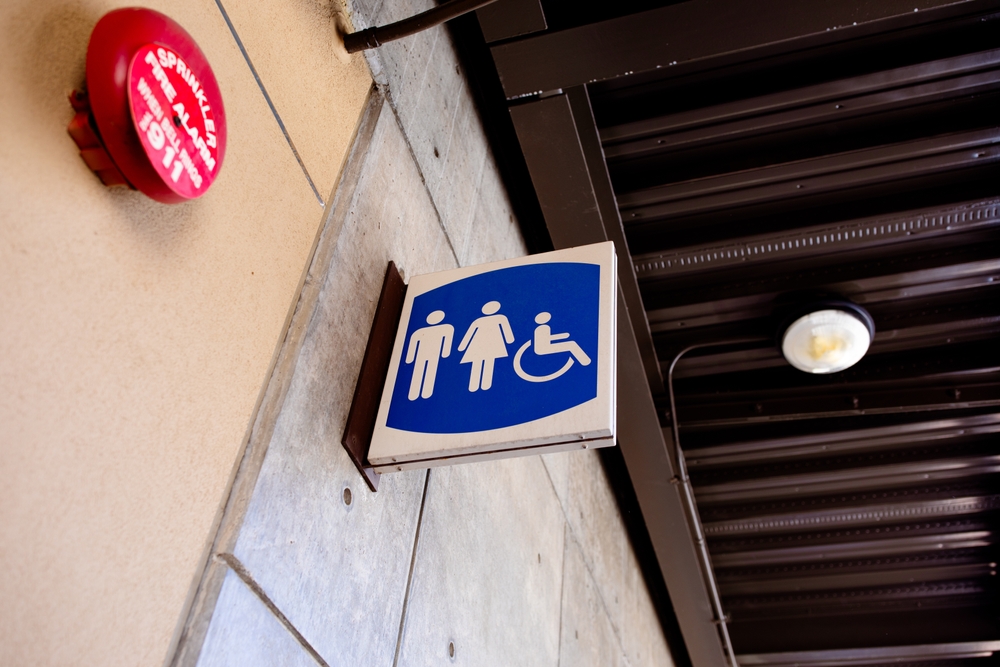ADA Unisex Restroom Layout Dimensions Guide

An ADA unisex restroom layout creates a fair and accessible space for all users. It supports people who need extra room, privacy, or mobility access.
Many facilities miss key details that make a restroom easy and safe to use. Turning space or grab bar placement can change how people move and feel inside the room.
This guide explains what defines an ADA-compliant unisex restroom. You’ll learn how to design one that meets accessibility standards and serves every visitor with comfort and care.
What Is an ADA-Compliant Unisex Restroom?
An ADA-compliant unisex restroom is a single-user toilet room that meets the layout and measurement standards set by the Americans with Disabilities Act (ADA).
It allows wheelchair users and people with limited mobility to move safely and use all plumbing fixtures without obstruction.
Every unisex toilet room should include a clear floor space and the required turning space needed for full movement.
The door swing can’t block this area, and the water closet should sit at the correct distance from the side wall and rear wall. Grab bars are mounted beside and behind the toilet to support users as they transfer.
An accessible lavatory should also have proper knee and toe clearance so someone using a wheelchair can roll forward without hitting the wall or other elements. The finished floor should be stable and level to prevent slips.
ADA Restroom Layout Requirements and Design Elements
Designing an ADA-compliant restroom means following exact measurements that support safe movement and access. Each part of the layout should work together to create an accessible space for all users.
Overall Room Layout and Clearances
The layout begins with clear floor space and required turning space. These areas allow wheelchair users to move freely inside the restroom.
A circular turning area with a 60-inch diameter meets the requirement, though a T-shaped space also works.
The door swing should never block these spaces. An outward swing helps prevent this issue. In single-user toilet rooms, an inward swing often traps a wheelchair, so an outward swing is the better choice.
Plan how users will move between the toilet, lavatory, and door. Clear pathways between fixtures prevent collisions and make the restroom easier to navigate.
Doors and Maneuvering Space
The door determines how easily someone can enter or exit. It should have at least 32 inches of clear width when open. The area near the door also needs space for movement.
The pull side requires 60 inches of depth and 18 inches beside the handle. For the push side, keep 48 inches of open space to make entry smooth and safe.
Handles should be simple and easy to operate with one hand. Lever handles work well since they require no twisting or a tight grip. Mount them between 34 and 48 inches above the finished floor.
When these details are correct, users can move through the toilet room with confidence and without strain.
Toilet Placement and Clearances
The water closet has to meet specific spacing requirements to allow easy transfers. Place it 16 to 18 inches from the side wall to the toilet’s centerline.
Maintain a clear floor space of 60 inches wide and 56 inches deep for a wall-mounted toilet.
The rear wall should leave enough room for grab bars and allow the user to reach the flush controls easily.
The toilet seat height should be between 17 and 19 inches from the finished floor to make transfers safe and comfortable.
Keep the area around the toilet clear of dispensers or trash bins. Even small obstructions can limit mobility and increase the risk of falls.
Grab Bars and Wall Requirements
Grab bars are critical for safety and stability. The side wall grab bar needs to measure at least 42 inches long. It should begin no more than 12 inches from the rear wall and extend at least 54 inches.
The rear wall grab bar should measure at least 36 inches long and be installed between 33 and 36 inches above the finished floor.
Choose materials that offer a strong grip. Stainless steel with a textured finish works best in commercial restrooms. Always attach grab bars to reinforced wall blocking to prevent accidents.
Accurate installation matters. Even a slight error in placement can cause a restroom to fail inspection or create safety issues for users.
Lavatory and Clearance Requirements
An accessible lavatory should support a forward approach. Provide at least 30 by 48 inches of clear floor space in front of the sink. The sink rim should not exceed 34 inches in height.
Beneath the sink, maintain 27 inches of knee clearance and 9 inches of toe clearance so a wheelchair can roll forward without obstruction.
Cover all exposed pipes to avoid burns or injuries. Install faucet controls that work with one hand and require minimal force. Lever and sensor faucets meet this need well.
Position the lavatory near the door when possible. This placement shortens travel distance and makes the restroom easier to use.
Accessories and Fixtures
Accessories also follow ADA standards. Mount mirrors so they have a bottom edge no higher than 40 inches above the finished floor.
Install shelves, dispensers, and hooks between 15 and 48 inches high so most users can reach them comfortably.
Avoid protruding objects that stick out more than 4 inches from the wall. Items such as hand dryers or paper towel dispensers can block movement or cause injury, especially for people with vision impairments.
When all fixtures follow ADA requirements, the toilet room functions smoothly and safely. Each element works together to create a clean, accessible, and welcoming space for every visitor.
ADA-Compliant Design for Multi-User and Historic Facilities
Designing restrooms for multi-user areas or qualified historic facilities requires careful planning. Each setting has its own challenges, but both must still meet ADA accessibility standards.
The goal is to create toilet rooms that are practical, safe, and easy for everyone to use.
Multi-User Restrooms
A multi-user restroom must include at least one accessible toilet compartment for each gender. When space limits make this difficult, an accessible unisex toilet room can act as an alternative.
This layout supports people who use personal care assistants or need privacy.
Key ADA requirements include:
- The door must provide a clear width of at least 32 inches when open.
- Each toilet compartment must have enough clear floor space and required turning space for a wheelchair.
- The water closet should be positioned 16 to 18 inches from the nearest side wall.
- Grab bars must be installed on both the side wall and the rear wall to support transfers.
- Include one accessible lavatory in each restroom that meets the same height and clearance rules used in single-user layouts.
- Accessories, mirrors, and dispensers must stay within ADA reach ranges for easy access.
Adding a nearby unisex toilet room makes the restroom more inclusive. It supports families, caregivers, and people who prefer additional privacy.
Historic Facilities
Older buildings often have structural limits that restrict updates. The ADA allows alternate methods that keep restrooms accessible while protecting historic details.
Common adjustments include:
- Repositioning plumbing fixtures to create better turning areas.
- Changing the door swing to open outward or away from fixtures.
- Installing a nearby lavatory that meets ADA requirements for height and access.
Even when space is tight, key accessibility features remain important. Include grab bars, proper turning areas, and a slip-resistant finish floor.
How to Design an ADA-Compliant Unisex Restroom
An ADA unisex restroom needs to balance accessibility and privacy. Each step below helps you meet the minimum requirements and maintain good restroom design standards.
- Measure the room size: Confirm the room depth and total room size. Include a 60-inch turning circle or a T-shaped space. This setup makes the restroom wheelchair accessible and easy to navigate.
- Plan the door and entry: Choose a door width of at least 32 inches. Keep free space on the latch side for entry. The door swing shouldn’t block the clear space near fixtures.
- Position the water closet: Place the water closet 16 to 18 inches from the side wall. Leave enough water closet clearance for a safe transfer. Add grab bars to the rear wall and side wall for support.
- Install the lavatory and fixtures: Set the sink no higher than 34 inches. Maintain proper knee and toe clearance and cover exposed pipes to follow plumbing codes.
- Add accessories: Mount mirrors, dispensers, and coat hooks within reach. Separate other plumbing fixtures to keep the space open and safe.
Meeting these clearances required helps you build a unisex restroom that’s accessible, practical, and fully ADA compliant.
ADA Unisex Restroom Etiquette and Best Practices
An ADA unisex restroom helps everyone access a safe, private space. It’s meant for people who need extra room or assistance, such as those who can’t use a women’s room or require help from someone of the opposite sex.
You can use an accessible stall when it’s the only one available, but it’s better to leave it open if other options exist.
Some disabilities aren’t visible, so it’s not always clear who needs that space. A respectful user keeps the restroom available for those who rely on it.
In some buildings, you’ll find two rooms side by side—one standard and one accessible. The ADA allows certain exceptions for older layouts, as long as equivalent facilitation is provided nearby.
For instance, an accessible toilet room may be located near a hallway instead of next to the main restroom.
Signs with raised characters help everyone identify these spaces quickly. When users respect the purpose and design of ADA restrooms, they help maintain access and dignity for everyone.
Design Your ADA Unisex Restroom With American Specialties Inc. Fixtures
American Specialties Inc. (ASI Group) helps you build ADA unisex restrooms that meet federal accessibility standards.
The company supplies grab bars, lavatories, toilet partitions, mirrors, and accessories that meet ADA-required clearance and minimum clearance guidelines.
Each ASI product meets national plumbing codes and fits standard restroom design layouts. You’ll find mirrors set at the correct reflecting surface height.
The company also offers durable work surfaces for handwashing or storage. Coat hooks are installed between 40 and 48 inches above the floor.
ASI offers slightly larger fixtures for layouts that need more space for wheelchair access and transfers. Its products serve public buildings, schools, healthcare centers, and residential dwelling units that require inclusive restroom layouts.
Visit ASI Group and browse their ADA-compliant toilets, lavatories, and accessories. You’ll find quality fixtures that complete your unisex restroom layout and create a space that’s accessible to every user.
FAQs About ADA Unisex Restroom Layout
What’s the smallest ADA unisex restroom?
An ADA unisex restroom needs enough space for a full wheelchair turn. The turning area should be at least 60 inches in diameter. The water closet, measured 16 to 18 inches from the side wall, gives more space for transfer.
Wall-mounted toilets need 56 inches of depth, while floor-mounted ones need 59 inches. These numbers meet the minimum clearance and required clearance for ADA standards.
What’s an ADA-compliant restroom?
An ADA-compliant restroom follows the Americans with Disabilities Act standards. It includes additional space and precise fixture placement for easy access.
Proper grab bars, a safe sink height, and an open side under the lavatory let users move freely.
These rules apply to public restrooms, residential dwelling units, and other facilities where accessibility is required.
How do you design an ADA-compliant unisex restroom?
Measure the room size and confirm enough turning space for a wheelchair. Position the water closet 16 to 18 inches from the wall. Add grab bars on the rear wall and side wall for balance.
Mount mirrors so the reflecting surface sits no higher than 40 inches. Keep sinks, dispensers, and urinals within ADA height limits to comply with accessibility standards.

